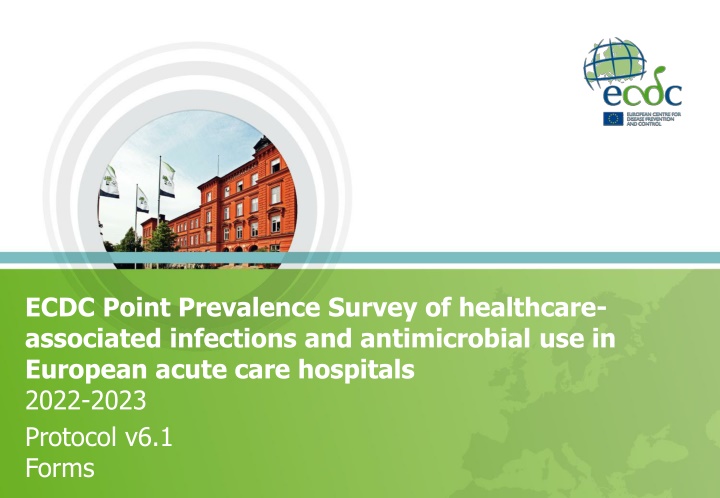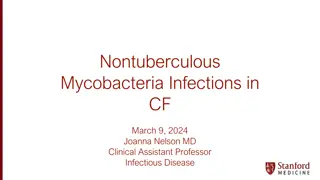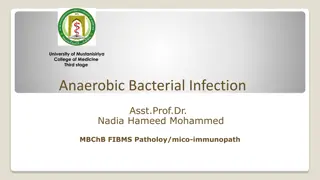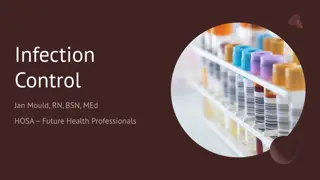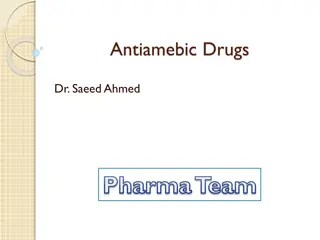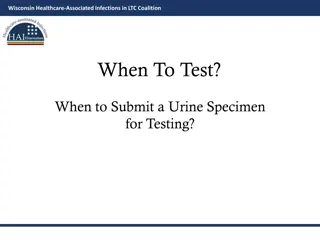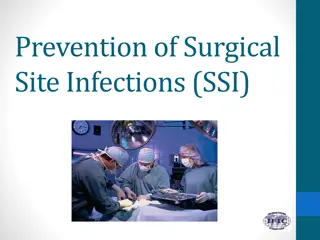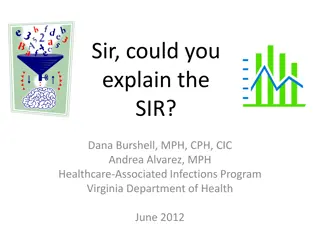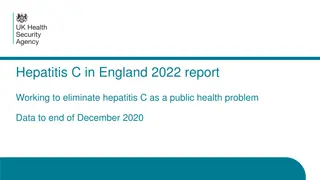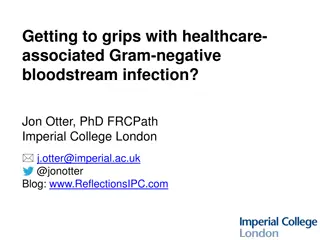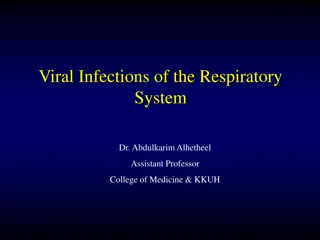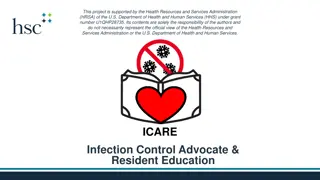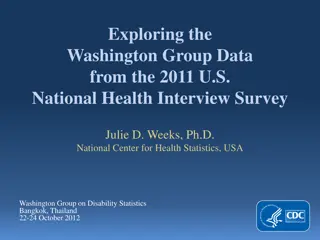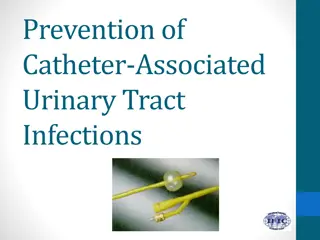ECDC Point Prevalence Survey of Healthcare-Associated Infections and Antimicrobial Use in European Acute Care Hospitals
This protocol outlines a comprehensive survey to gather data on healthcare-associated infections and antimicrobial use in European acute care hospitals. The forms included cover patient data, antimicrobial use, diagnoses, and reasons for changes in treatment. The survey also collects information on hospital codes, ward names, patient demographics, vaccination status, and other relevant factors to assess prevalence and trends in infections and antimicrobial usage.
Download Presentation

Please find below an Image/Link to download the presentation.
The content on the website is provided AS IS for your information and personal use only. It may not be sold, licensed, or shared on other websites without obtaining consent from the author.If you encounter any issues during the download, it is possible that the publisher has removed the file from their server.
You are allowed to download the files provided on this website for personal or commercial use, subject to the condition that they are used lawfully. All files are the property of their respective owners.
The content on the website is provided AS IS for your information and personal use only. It may not be sold, licensed, or shared on other websites without obtaining consent from the author.
E N D
Presentation Transcript
ECDC Point Prevalence Survey of healthcare- associated infections and antimicrobial use in European acute care hospitals 2022-2023 Protocol v6.1 Forms
ECDC point prevalence survey of healthcare-associated infections and antimicrobial use Form A. Standard option: Patient data, Antimicrobial (AM) use and HAI data Antimicrobial (generic or brand name) Diagnosis (site) Reason in notes Changed? (+ reason) Route Indication Patient data (to collect for all patients) Hospital code [__________] Ward name (abbr.)/Unit Id [__________] Survey date: ___ / ___ / 20___ (dd/mm/yyyy) Patient Counter: [_________________________________] Route: P: parenteral, O: oral, R: rectal, I: inhalation; Indication: treatment intention for community (CI), long- term care (LI) or acute hospital (HI) infection; surgical prophylaxis: SP1: single dose, SP2: one day, SP3: >1 day; MP: medical prophylaxis; O: other; UI: Unknown indication; Diagnosis: see site list, only for CI-LI-HI; Reason in notes: Y/N; AM Changed? (+ reason): N=no change; E=escalation; D=De-escalation; S=switch IV to oral; A=adverse effects; OU=changed, other/unknown reason; U=unknown; Age in years: [____] yrs; Age if < 2 year old: [_____] months Sex: M / F Date of hospital admission: ___ / ___ / _____ dd / mm / yyyy Consultant/Patient Specialty: [__________] HAI 1 HAI 2 If neonate, birth weight: [______] grams - Case definition code Surgery since admission: O No surgery O NHSN surgery -> specify (optional): [__________] O Unknown O Yes O No O Unknown O Yes O No O Unknown Relevant device (3) O Minimal invasive/non-NHSN surgery O Yes O No O Yes O No Present on admission / / / / Date of onset (4) McCabe score: O Non-fatal disease O Rapidly fatal disease O current hospital O other hospital O LTCF O other/ unk O current hospital O other hospital O LTCF O other/ unk O Ultimately fatal disease O Unknown Origin of infection HAI associated to current ward O Yes O No O Unknown O Yes O No O Unknown Vaccinated against COVID-19: O No O Partial O Full -> additional doses O 1 O >=2 O Unknown O Yes O No O Unknown O Yes O No O Unknown Vasopressor treatment No Yes Unk Central vascular catheter: If BSI: source (5) Urinary catheter: No Yes Unk P D R P D R AMR AMR No Yes Unk Intubation: MO code MO code AM (6) SIR AM (6) SIR Patient receives antimicrobial(s)(1): No Yes Microorganism 1 IF YES Patient has active HAI(2): No Yes Microorganism 2 (1) At the time of the survey, except for surgical prophylaxis 24h before 8:00 AM on the day of the survey; if yes, fill antimicrobial use data; if patient receives >4 antimicrobials, add a new form; (2) [infection with onset Day 3, OR SSI criteria met (surgery in previous 30d/90d), OR discharged/transferred from HCF <48h ago, OR CDI and discharged from HCF < 28 days ago OR onset < Day 3 after invasive device/procedure on D1 or D2 OR COVID-19 on day 1 or day 2 and (re-)admission within 48 hours after stay in HCF of >7 days OR onset <day 3 after birth in neonates] AND [HAI case criteria met on survey day OR patient is receiving (any) treatment for HAI AND case criteria are met between D1 of treatment and survey day]; if yes, fill HAI data; if patient has > 2 HAIs, add new form; HCF=healthcare facility. Microorganism 3 (3) relevant device use before onset infection (intubation for PN, CVC/PVC for BSI, urinary catheter for UTI); (4) Only for infections not present/active on admission (dd/mm/yyyy); (5) C-CVC, C-PVC, S-PUL, S-UTI, S-DIG, S- SSI, S-SST, S-OTH, UO, UNK; (6) AB: tested antibiotic(s): S. aureus: OXA+ GLY; Enterococci: GLY; Enterobacterales: C3G + CAR; P. aeruginosa and Acinetobacter spp.: CAR; SIR: S=susceptible, standard, I=susceptible, increased exp, R=resistant, U=unk; PDR: pandrug-resistant: N=no, P=possible, C=confirmed, U=Unk
ECDC point prevalence survey of healthcare-associated infections and antimicrobial use Form B. Light option: Antimicrobial (AM) use and HAI data Antimicrobial (generic or brand name) Diagnosis (site) Reason in notes Changed? (+ reason) Route Indication Patient data (patients with HAI and/or antimicrobial only) Hospital code [__________] Ward name (abbr.)/Unit Id [__________] Patient Counter: [_________________________________] Route: P: parenteral, O: oral, R: rectal, I: inhalation; Indication: treatment intention for community (CI), long- term care (LI) or acute hospital (HI) infection; surgical prophylaxis: SP1: single dose, SP2: one day, SP3: >1 day; MP: medical prophylaxis; O: other; UI: Unknown indication; Diagnosis: see site list, only for CI-LI-HI; Reason in notes: Y/N; AM Changed? (+ reason): N=no change; E=escalation; D=De-escalation; S=switch IV to oral; A=adverse effects; OU=changed, other/unknown reason; U=unknown; Age in years: [____] yrs; Age if < 2 years old: [_____] months Sex: M / F Date of hospital admission: ___ / ___ / _____ (dd/mm/yyyy) HAI 1 HAI 2 Consultant/Patient Specialty: [__________] Case definition code Patient receives antimicrobial(s)(1): No Yes IF YES O Yes O No O Unknown O Yes O No O Unknown Relevant device (3) Patient has active HAI(2): No Yes O Yes O No O Yes O No Present on admission (1) At the time of the survey, except for surgical prophylaxis 24h before 8:00 AM on the day of the survey; if yes, fill antimicrobial use data; if patient receives >4 antimicrobials, add a new form; (2) [infection with onset Day 3, OR SSI criteria met (surgery in previous 30d/90d), OR discharged/transferred from HCF<48h ago, OR CDI and discharged from HCF < 28 days ago OR onset < Day 3 after invasive device/procedure on D1 or D2 OR COVID-19 on day 1 or day 2 and (re-)admission within 48 hours after stay in HCF of >7 days OR onset <day 3 after birth in neonates] AND [HAI case criteria met on survey day OR patient is receiving (any) treatment for HAI AND case criteria are met between D1 of treatment and survey day]; if yes, fill HAI data; if patient has > 2 HAIs, add new form; HCF=healthcare facility / / / / Date of onset (4) O current hospital O other hospital O LTCF O other/ unk O current hospital O other hospital O LTCF O other/ unk Origin of infection HAI associated to current ward O Yes O No O Unknown O Yes O No O Unknown O Yes O No O Unknown O Yes O No O Unknown Vasopressor treatment If BSI: source (5) P D R P D R AMR AMR MO code MO code AM (6) SIR AM (6) SIR Microorganism 1 Microorganism 2 Microorganism 3 (3) relevant device use before onset infection (intubation for PN, CVC/PVC for BSI, urinary catheter for UTI); (4) Only for infections not present/active on admission (dd/mm/yyyy); (5) C-CVC, C-PVC, S-PUL, S-UTI, S-DIG, S- SSI, S-SST, S-OTH, UO, UNK; (6) AB: tested antibiotic(s): S. aureus: OXA+ GLY; Enterococci: GLY; Enterobacterales: C3G + CAR; P. aeruginosa and Acinetobacter spp.: CAR; SIR: S=susceptible, standard, I=susceptible, increased exp, R=resistant, U=unk; PDR: pandrug-resistant: N=no, P=possible, C=confirmed, U=Unk
ECDC point prevalence survey of healthcare-associated infections and antimicrobial use Form H1. Hospital data 1/4 Year data Inc./ Total (1) Hospital code: Number Number of discharges/admissions in year Survey dates: From __ / __ /____ To: __ / __ /____ dd / mm / yyyy dd / mm / yyyy Inc Tot Number of patient-days in year Hospital size (total number of beds) Number of acute care beds Number of ICU beds Alcohol hand rub consumption liters/year Inc Tot N observed hand hygiene opportunities/year Inc Tot Exclusion of wards for PPS? No Yes, please specify which ward types were excluded: _______________________________________________ Number of blood culture sets/year Inc Tot Number of stool tests for CDI/year Inc Tot Number of FTE infection control nurses Total number of beds in included wards: Total number of patients included in PPS: Hospital type Primary Secondary Tertiary Specialised, specify : ______________________ Hospital ownership: Public Private, not-for-profit Private, for profit Other/unknown Number of FTE infection control doctors Inc Tot Number of FTE antimicrobial stewardship consultants N of COVID-19 cases in hospital last year Number of COVID-19 outbreaks last year N of current COVID-19 cases in hospital PPS Protocol: Standard Light Is the hospital part of a national representative sample of hospitals ? No Number of current COVID-19 cases in ICU Yes Unknown Vaccination coverage HCW COVID-19 (%) (1) Data were collected forincluded wards only (Inc = recommended) or for the total hospital (Tot); if all wards were included in PPS (Inc = Tot), mark Inc ; N=Number Vaccination coverage HCW Influenza (%) N of airborne infection isolation rooms
ECDC point prevalence survey of healthcare-associated infections and antimicrobial use Form H2. Hospital data 2/4 Current degree of automation of surveillance of HAIs: Hospital code: 0.Fully manual denominator 1.Automated automated automated performed 4. other 2.Semi- Survey dates: From __ / __ /____ To: __ / __ /____ dd / mm / yyyy dd / mm / yyyy 3.Fully 9. Not Infection prevention and control (IPC) programme: Is there an annual IPC plan, approved by the hospital CEO or a senior executive officer? Yes Surgical site infection* Hospital-onset BSI No Central line-associated BSI Is there an annual IPC report, approved by the hospital CEO or a senior executive officer? Yes No Catheter-associated UTI Hospital-acquired pneumonia Participation in surveillance networks: In the previous year, which surveillance networks did your hospital participate in ? (tick all that apply) SSI ICU CDI Antimicrobial resistance Antimicrobial consumption Other, specify ____________ ________________________________________________ Microbiology/diagnostic services: On weekends, can clinicians request routine microbiological tests and get back results? Clinical tests: Saturday Sunday Screening tests: Saturday Sunday Ventilator-associated pneumonia Clostridoides difficile infection Feasibility of automated HAI surveillance: Data source Data exist in a digital subsystem Data are structured and well-defined Surgical procedures (procedure code such as ICD-10, date of surgery) Admission and discharge dates, hospital level Admission and discharge dates, unit level Use of central lines (date of insertion/extraction, type) Use of mechanical ventilation (start date, end date) Use of urinary catheters* (date of insertion/extraction) Microbiology culture results (culture result, date, specimen type) Antimicrobial prescriptions (ATC code, start date, end date) COVID-19 prevention: Is there currently a policy of universal masking in place in your hospital? O No O Yes, for routine care only O Yes, for routine care and in all common areas (e.g. doctors room) CEO: Chief Executive Officer, Managing Director; SSI: surgical site infections; ICU: intensive care unit (HAIs in ICUs); CDI: Clostridoides difficile infection ; BSI: bloodstream infection; UTI: urinary tract infection
ECDC point prevalence survey of healthcare-associated infections and antimicrobial use Form H3. Hospital data 3/4 Hospital code: Optional: Full WHO IPCAF questionnaire provided O Yes O No If No, please complete the questions 1-5 below Survey dates: From __ / __ /____ To: __ / __ /____ dd / mm / yyyy dd / mm / yyyy Multimodal strategies for implementation of IPC interventions (WHO core component 5) 1. Do you use multimodal strategies to implement IPC interventions? O No O Yes O Unknown 2. Do your multimodal strategies include any or all of the following elements: - System change: O Element not included in multimodal strategies O Interventions to ensure the necessary infrastructure and continuous availability of supplies are in place O Interventions to ensure the necessary infrastructure and continuous availability of supplies are in place and addressing ergonomics and accessibility (e.g. best placement of central venous catheter set and tray) - Education and training: O Element not included in multimodal strategies O Written information and/or oral instruction and/or e-learning only O Additional interactive training sessions (includes simulation and/or bedside training) - Monitoring and feedback: O Element not included in multimodal strategies O Monitoring compliance with process or outcome indicators (e.g. audits of hand hygiene or catheter practices) O Monitoring compliance and providing timely feedback of monitoring results to healthcare workers and key players - Communications and reminders: O Element not included in multimodal strategies O Reminders, posters, or other advocacy/awareness-raising tools to promote the intervention O Additional methods/initiatives to improve team communication across units and disciplines (e.g., by establishing regular case conferences and feedback rounds) - Safety climate and culture change: O Element not included in multimodal strategies O Managers/leaders show visible support and act as champions and role models, promoting an adaptive approach and strengthening a culture that supports IPC, patient safety and quality O Additionally, teams and individuals are empowered so that they perceive ownership of the intervention (e.g., by participatory feedback rounds) 3. Is a multidisciplinary team used to implement IPC multimodal strategies? O No O Yes O Unknown 4. Do you regularly link to colleagues from quality improvement and patient safety to develop and promote IPC multimodal strategies? O No O Yes O Unknown 5. Do these strategies include bundles or checklists? O No O Yes O Unknown Comments/observations for the current hospital PPS: __________________________________________________________ ______________________________________________________________________________________________
ECDC point prevalence survey of healthcare-associated infections and antimicrobial use Form H4. Hospital data 4/4 Hospital code: Survey dates: From __ / __ /____ To: __ / __ /____ dd / mm / yyyy dd / mm / yyyy Optional: ward indicators collected at hospital-wide level: Inc./ Total (1) Number Number of beds with AHR dispensers at point of care Number of beds assessed for presence of AHR dispensers Number of patient rooms in hospital Number of single patient rooms in hospital Number of beds occupied at 00:01 on the day of PPS Number of beds assessed for occupancy at 00:01 on the day of PPS (1) Data were collected forIncluded wards only (Inc = recommended) or for the total hospital (Tot); if all wards were included in PPS (Inc=Tot), mark Inc In your hospital, do healthcare workers (HCWs) carry AHR dispensers (e.g. in their pockets) ? (if yes, please estimate percentage) O No O >0-25% of HCWs O >25-50% of HCWs O >50-75% of HCWs O >75% of HCWs O Yes, percentage unknown Is there a formal procedure to review the appropriateness of an antimicrobial within 72 hours from the initial order in the hospital (post-prescription review)? O Yes, in all wards O Yes, in selected wards only O Yes, in ICU onlyO No AHR = Alcohol-based hand rub; Variables Number of beds assessed for presence of AHR dispensers and Number of beds assessed for occupancy at 00:01 on the day of PPS are denominator data, typically same number as the total number of beds in the hospital; ICU=intensive care unit.
ECDC point prevalence survey of healthcare-associated infections and antimicrobial use Form W. Ward data Hospital code [__________] Ward name (abbr.) /Unit Id [__________] Survey date1: ___ / ___ / _______ dd / mm / yyyy Ward specialty2 PED NEO ICU MED SUR G/O GER PSY RHB LTC OTH MIX Is there a formal procedure to review the appropriateness of an antimicrobial within 72 hours from the initial order in this ward (post- prescription review)? O Yes O No Hospital site code (optional) [__________] Total number of patients in ward3 [__________] Number of patients by consultant/patient specialty (LIGHT option only): Number Year5 Number of patient-days in ward / year Alcohol hand rub consumption in ward liters/year6 Consultant/patient Specialty Number of patients in ward4 N of hand hygiene opportunities observed /year Number of beds in ward N of beds with AHR dispensers at point of care Number of HCWs on ward at time of PPS Number of HCWs on ward carrying AHR dispensers Number of rooms in ward Number of single rooms in ward N of beds occupied at 00:01 on the day of PPS 1 Patients on the same ward should be included on a single day if possible; 2 Main ward specialty: >=80% of patients belong to this specialty, otherwise choose mixed 3 Optional for standard, mandatory for light protocol option; 3-4 number of patients admitted to the ward before or at 8:00 AM and not discharged from the ward at time of the survey; 5 Year: year of data, previous year or most recent available year; 6 Alcohol hand rub solution in liters delivered to the ward during the same year; N = number; AHR=alcohol hand rub; HCW=healthcare worker. Comments/observations: _________________________________________________________________________
ECDC point prevalence survey of healthcare-associated infections and antimicrobial use Form N. National/regional data Country Code: _____ Network ID/Data Source: _____ N Year data Date start PPS : __ / __ /____ Total N of acute care hospitals ( sites ) National/regional PPS coordination centre/institute: Number of administrative hospital groups ________________________________________________ Total N of beds in acute care hospitals National/regional PPS coordination programme/unit: Total N of acute care beds Name: ____________________________________________ Website: __________________________________________ Number of discharges/admissions, all Number of discharges/admissions, acute care beds only National COVID-19 vaccine regimen considered as full vaccination of healthcare workers at the time of the PPS: O A: full baseline vaccination O A + one additional dose O 2 additional doses O >=3 additional doses; O other, please specify: ___________________________________________ __________________________________________________ Number of patient-days, all Number of patient-days, acute care beds only Method of sampling/recruitment of hospitals (more than 1 answer possible): O representative systematic random sample O all hospitals invited O other representative sample O voluntary participation O convenience sample (selection) O mandatory participation Total number of hospitals in PPS: Light (unit-based) protocol ____ Standard (patient-based) protocol _____ Number of hospitals submitted to ECDC: Light (unit-based) protocol ____ Standard (patient-based) protocol _____ Comments/observations: _____________________________________________________________________________________________________________ _____________________________________________________________________________________________________________
